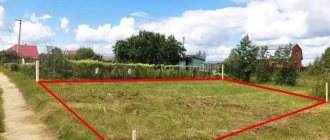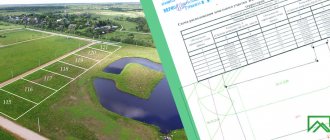1. Unauthorized buildings
2. Reducing the cadastral value of a land plot
3. Division of the house in kind
4. Acquisitive prescription for a land plot
5. Cadastral error
Land disputes are one of the types of conflicts that arise between landowners and land users due to violation of the rights of one of these parties. The causes of disputes, as a rule, lie in claims relating to the purchase or, conversely, sale, other transfer of ownership of a plot, use of land, its lease, non-compliance with land easements, good neighborliness rules arising as a result of damage to land owners, obligations and the like reasons.
Problematic issues of judicial practice
Judicial practice on land disputes indicates that disputes relating to land issues belong to one of the most difficult categories. This is due to several reasons:
- Land, as an object of property, was for a long time exclusively in state ownership. In the USSR, private property did not exist in principle and, therefore, judicial practice cannot boast of great diversity. The opportunity to privatize land plots appeared a little more than 20 years ago, and this is the minimum period for the formation of any trends in law.
- Changes in legislation relating to land law occur with regularity, which does not help clarify the situation in judicial practice.
- Many difficulties arise in determining the departmental nature of the issue, namely, determining where the dispute should be considered: in an economic court, civil or administrative.
A review of judicial practice suggests that courts of general jurisdiction do not have the right to examine claims and complaints related to the seizure of land for state use, allocation, lease, termination of rights, alienation or purchase of land plots and all other land disputes, if the participants conflicts are legal entities, regardless of their organizational and legal form, entrepreneurs or farms, since cases of this kind belong to arbitration courts.
Recently, judicial practice has become widespread due to the great interest in the land resource of legal entities, citizens, and authorities. Statistics show that since about 1996, the number of disputes related to land issues has more than doubled every year.
In order to make it possible to relieve the workload of courts of general jurisdiction and arbitration courts, as well as to ensure that decisions are made at a more qualified level, issues of forming special land courts with special powers and formation procedures are increasingly being considered. Such judicial practice in land disputes exists in many states. For example, in Germany, land disputes are considered in an agricultural court, and in Australia in a special land court.
Peculiarities of judicial practice in land disputes between neighbors
In what cases can land disputes arise between neighbors?
A plot of land is the basis of any person’s real estate. This is largely due to the fact that the land is the territory where capital construction projects are located.
In addition, some types of plots can be completely legally used for the introduction of agricultural activities and other types of commercial use.
Given such a high value of land, the concept of a “land dispute” does not seem outlandish or, in part, wild.
Modern realities are such that a plot of land can become a cause of confrontation due to numerous factors.
Often the basis among these is an extremely simple phenomenon - one person, without the knowledge of another, either uses his land for his own purposes, or has illegally appropriated his plot. In such a case, the position of a citizen or organization can be either justified or extremely subjective, without any evidence.
However, in any dispute described, it does not matter whether they take place in reality or not, the potentially injured party has the right to defend their rights and freedoms by going to court.
The foundations of land legal proceedings are laid down in a whole list of legislative acts. For general information, let’s pay attention to them:
- The Constitution, or rather its article number 36, regulates the right of any citizen of the Russian Federation to own land and protect their rights to it.
- The Land Code of the Russian Federation (LK RF), which defines the characteristics of a land plot that can act as the subject of a land dispute. In particular, such a site must be owned by someone and be suitable for some use. The Land Code also determines methods for resolving disputes and the subsequent course of action of the parties to the conflict (for example, it obliges them to register the boundaries of the site in the manner determined by the court).
- The Civil Procedure Code of the Russian Federation (Civil Procedure Code of the Russian Federation), which regulates the general principle of legal proceedings in our country, and also states that the subject of a land dispute in court can only be that plot that is tied to a certain area in Russia, not otherwise. That is, the courts of the Russian Federation will not consider cases regarding the land ownership of our citizens in neighboring countries.
As noted earlier, the cause of all disputes over Russian land is the unlawful or potentially unlawful use of the site by any person.
In a narrower context of consideration of this issue, the following common causes of land disputes can be identified:
- inconsistencies in cadastral documentation, violating the boundaries of neighbors’ plots and provoking disputes between them;
- errors in the preparation of cadastral documentation, which have consequences similar to those described above;
- problems associated with renting a specific site;
- problems regarding determining the owner of the land or its survey>;
- other factors provoking civil conflicts, the subject of which are land plots.
Classification of land disputes
Disputes regarding land relations usually concern the acquisition, change or loss (termination) of rights to land. They can arise directly between two or more users, as well as between the user or owner and the state, local government bodies and the regulation of relations relating to this object of law. Depending on the method of considering the dispute and its participants, a review of judicial practice on land issues allows us to classify emerging conflicts into:
- Administrative;
- Judicial;
- According to the object of the conflict;
- According to the subject of the conflict.
Disputes arising on land are of the following types:
- Failure to comply with the rules for the provision of plots. An example of such a violation is the allocation of land for construction affecting the environmental and other interests of citizens. There are times when such disputes must be resolved through a local referendum or public consultation.
- Failure to respect rights when using land. Both the tenant and the person who owns the land have the right to go to court and challenge actions that interfere with the conduct of economic activities or ownership of the site, or unlawful interference with activities. Since the right to conduct independent economic activity is defined by law and can be violated only in cases where environmental safety, national security, etc. are affected.
- Unlawful seizure of land.
- Violations during land planning works.
- Disagreement with decisions on negative claims.
- Disagreement with decisions related to compensation for losses caused during the use of land.
- Occupation, use of land without having rights to it.
- Disagreements in determining the rights to use the site and others.
- Failure to comply with the boundaries of land use, its illegal transfer, division.
Advice: to prove that you are right in a conflict about the erroneous delimitation of boundaries, in addition to providing documents certifying ownership, you should order a delimitation examination, which is carried out by a cadastral engineer. The more convincing the evidence presented to the court, the greater the chance of success.
The current legislation of the Russian Federation provides for the following types of formation of rights to land plots:
- Perpetual use, not subject to investigation;
- Inherited property for life;
- Own;
- Easement;
- Free use for a limited period;
- Land lease.
Each of the emerging land disputes has its own special nature and must be resolved taking into account individual characteristics: material, procedural, legal.
Advice: given the complexity and ambiguity of conflicts relating to the land issue and the lack of diverse judicial practice, you should not resolve the issue yourself. Conflicts that arise should be resolved as quickly as possible, and it is unrealistic to become an expert in this field and study all the intricacies of a case in a short time, so to minimize the risk of problems arising as a result of the consideration of the case, seek advice from professional lawyers.
Land litigation. Where do disagreements come from?
Land disputes are disagreements and conflicts regarding the violation of the rights of owners by third parties in terms of ownership, use or disposal of a land plot, as well as disagreements and conflicts between the owners of land plots themselves (if we are talking about common shared or joint ownership of land).
All land plots, their characteristics and ownership rights to them are subject to registration and accounting in the all-Russian land cadastre. Land legal relations are regulated by the norms of the Constitution of the Russian Federation, the Civil and Land Codes of the Russian Federation, certain special laws and by-laws.
The subjects of land legal relations are citizens and legal entities, the state and municipalities, and the objects are property rights and other proprietary rights to land plots.
Most often, land disputes are associated with incorrect registration and recognition of land ownership, with the seizure of other people's territories, determination of the procedure for using a land plot, violation of the rights of adjacent land users during land surveying, the establishment of land easements, the use of leased land areas for other purposes, causing intentional or through negligence, harm to land users and land owners.
There are also often land disputes regarding the recognition of illegal actions of various state and municipal bodies, the division of land plots, registration of transactions with land, compulsion to conclude a lease agreement, conflicts in connection with the forced seizure of land, allotment of a land plot, land management, inheritance of land, etc. d.
The procedure for considering disputes and implementing decisions
After the Decree of the President of the Russian Federation of December 24, 1933 No. 2287, which amended the Land Code of the Russian Federation, came into force, participants in the land conflict received the right to resolve their disputes directly in the courts without contacting local authorities. Thus, disputes on land issues are subject to consideration exclusively in a general or arbitration court, with the exception of cases where the parties to the dispute independently appealed to the administrative authorities before the case was accepted into judicial practice. In this case, claims can be considered administratively, and in case of disagreement with the decision made, as evidenced by a review of judicial practice, it can be appealed in court. From a review of judicial practice on land disputes, it is clear that different approaches are provided for the execution of adopted decisions, depending on who is the defendant: a legal entity or an individual.
If an organization is liable under a writ of execution with all its property, then legal restrictions are provided for citizens regarding property that cannot be recovered.
For a more orderly solution to such issues, judicial practice uses the explanations given in Resolution No. 11 of March 24, 2005, adopted at the Plenum of the Supreme Arbitration Court of the Russian Federation. This document presents methods for solving problems that arise in the process of re-registration of a land plot. Another document that courts take into account when resolving land conflicts is the information letter of the Presidium of the Supreme Arbitration Court of the Russian Federation dated January 28, 2005 N 90, which considers the practice of arbitration courts in considering cases related to mortgage issues. The practice of resolving a land dispute arises from the moment when the party having a claim goes to the court, which is authorized to consider and resolve the conflict that has arisen.
Land disputes with neighbors: establishing the boundaries of a land plot
The boundaries of a land plot often become the subject of land disputes between owners. The reason for the dispute lies either in a cadastral error or in the actual boundaries between land plots. Quite often the dispute is resolved in court. The problem becomes the correct formulation of requirements and the identification of persons to whom they should be presented. The conclusions made in the article are confirmed by the judicial practice of the Supreme Court of the Russian Federation and decisions of the courts of the Voronezh region.
articles:
1. Land disputes in the 21st century.
2. What to do if there is a dispute about the actual boundaries of a land plot?
3. What to do if there is a cadastral error?
conclusions
Land disputes in the 21st century
The most common requirement arising from a land dispute between neighbors is the establishment of the boundaries of a land plot.
How to avoid land disputes - this issue still remains relevant in the 21st century. It is surprising that this problem has not been solved even after the introduction of land surveying and its cadastral registration.
Judicial practice in land disputes remains quite common and, moreover, is becoming more complex every day. Today, it is almost impossible to resolve a land dispute without the participation of a lawyer specializing in land matters, since it requires not only special knowledge in the field of civil and land law, but also orientation in the constantly changing judicial practice.
It is necessary to clearly understand that judicial practice in land cases proceeds from the fact that the implementation of cadastral registration by the owners of land plots does not exclude a dispute about the boundaries between them, therefore, the cadastral registration of a land plot of an adjacent owner (user) and the registration of the right to it do not in themselves in all cases, they indicate the final determination of the adjacent border (appeal determination of the judicial panel for civil cases of the Voronezh Regional Court dated August 14, 2018, case No. 33-5168/2018).
According to a summary of the judicial practice of the Voronezh Regional Court on disputes arising from land legal relations for the 1st half of 2020, in order to correctly establish legally significant circumstances in each case, when preparing a case on establishing the boundaries of a land plot for trial, the plaintiff and defendant should be invited to submit primary title documents for land. We are talking about resolutions of local government bodies on the provision of a land plot, acts of land allotment and other primary allotment documents.
When making such a claim, it must be established whether the imposition of the land use boundaries of the plaintiff and defendants is factual, that is, whether there is a dispute between these persons about the actual location of the land plots.
It is necessary to take into account that a dispute about the right or a boundary dispute cannot be resolved only by satisfying the demand submitted to the cadastral registration authority to deregister a land plot, since, as the Supreme Court of the Russian Federation indicated, the dispute arises on the issue of the actual border of adjacent plots .
The dispute that has arisen between the parties cannot actually remain unresolved, since there will be a violation of the provisions of Article 2 of the Civil Procedure Code of the Russian Federation. The dispute must be resolved in any case, since there are no grounds for refusing to satisfy the requirement to establish the boundaries of the land plot, and the resolution of this dispute is impossible through correction of the cadastral error due to the existence of a dispute about the right, and therefore, the appropriate way to protect the violated right is to present a claim to invalidate the results of cadastral work and to establish the location of the adjacent border.
What to do if there is a dispute about the actual boundaries of a land plot?
As a general rule, if there is a dispute between persons about the actual boundaries between adjacent land plots, claims are made in court to invalidate and subject to exclusion the information included in the Unified State Register of Real Estate describing the location of the boundaries of a land plot with the corresponding cadastral number, in part of the adjacent border with the land plot of the interested party, as well as on approval of the location of the adjacent border between the disputed land plots at the coordinates specified in the expert report, since this expert report establishes the actual boundaries of the land plots.
As a rule, evidence in this category of cases is the conclusion of a forensic land survey, confirming the presence of a fence or other fencing (an existing wall of a building) between the plots, which is the actual adjacent border of these plots over a long period of time (more than 10 years), and containing a conclusion that that the information contained in the Unified State Register of Real Estate (USRN) about the location of a land plot with the corresponding cadastral number does not comply with the provisions of the norms related to the implementation of cadastral registration of real estate, violates the rights of other persons, and is subject to exclusion from the USRN.
Documentation
In accordance with judicial practice, to resolve most conflicts regarding land disputes, you should file:
- A deed confirming ownership of a plot of land (original or copy);
- Passport (copy);
- Identification code.
If the party filing the claim needs to resolve a controversial issue regarding the re-registration of the state act of ownership of land or amendments to the act in terms of changing the owner of the plot, an additional package of documents will be required to be submitted:
- Agreement on the transfer of rights (donation, purchase/sale, exchange);
- A certificate confirming the inheritance of land;
- Other documents certifying the transfer of ownership.





